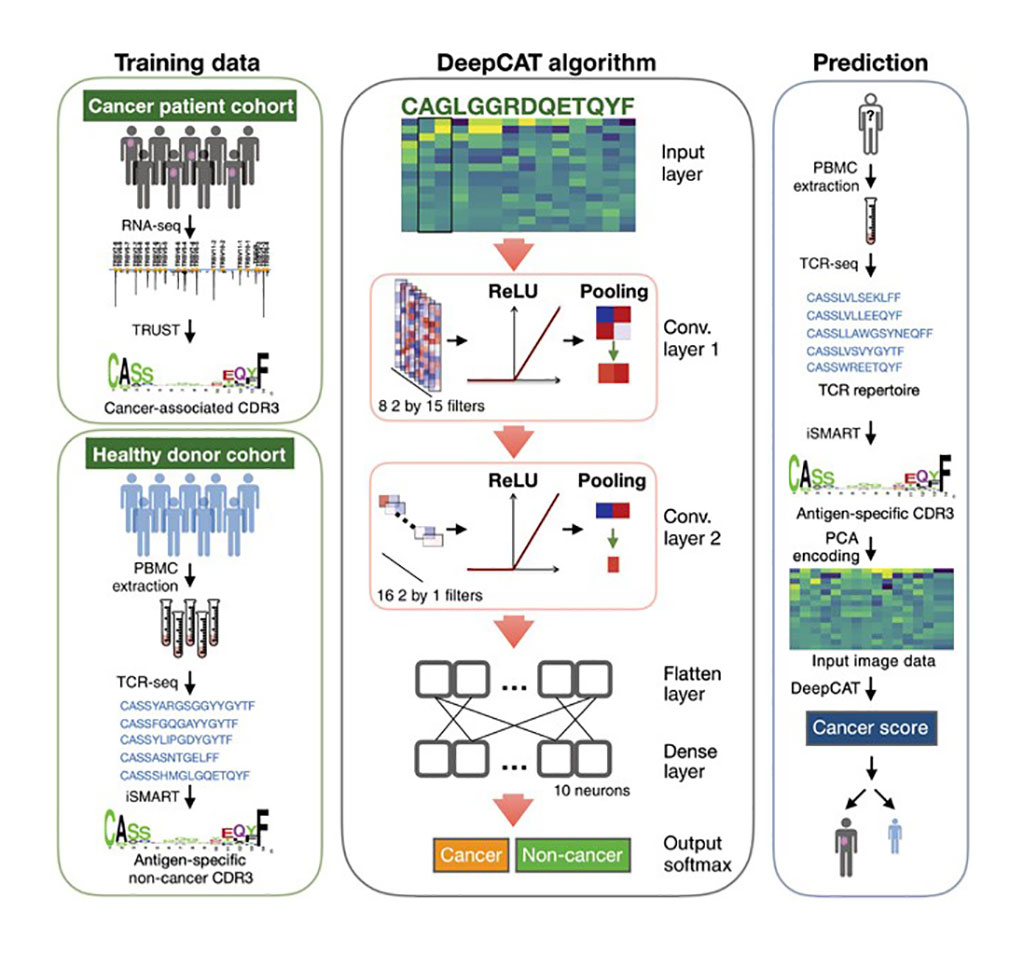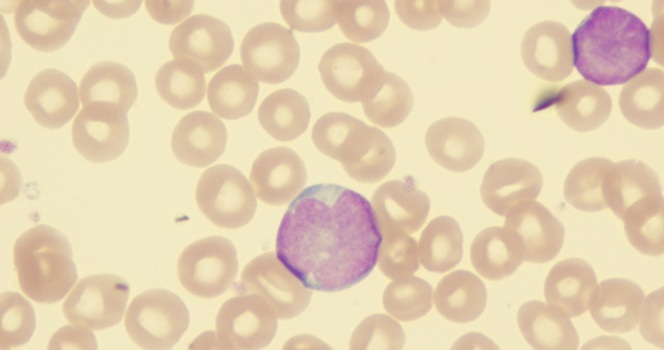Cancer-Associated T Cell Receptors Evaluated for Malignancy Detection
|
By LabMedica International staff writers Posted on 31 Aug 2020 |

Image: De novo prediction of cancer-associated T cell receptors for noninvasive cancer detection (Photo courtesy of UT Southwestern Medical Center).
A key goal in oncology is diagnosing cancer early, when it is more treatable. Despite decades of progress, early diagnosis of asymptomatic patients remains a major challenge. Most methods for this involve detecting cancer cells, but a different approach, focused on the body’s immune response.
The adaptive immune system recognizes tumor antigens at an early stage to eradicate cancer cells. This process is accompanied by systemic proliferation of the tumor antigen–specific T lymphocytes. While detection of asymptomatic early-stage cancers is challenging due to small tumor size and limited somatic alterations, tracking peripheral T cell repertoire changes may provide an attractive solution to cancer diagnosis.
Medical scientists at the UT Southwestern Medical Center (Dallas, TX,USA) developed a deep learning method called DeepCAT to enable de novo prediction of cancer-associated T cell receptors (TCRs). They validated DeepCAT using cancer-specific or non-cancer TCRs obtained from multiple major histocompatibility complex I (MHC-I) multimer-sorting studies and demonstrated its prediction power for TCRs specific to cancer antigens. DeepCAT is used by applying a computational method for detecting tumor-infiltrating T cell CDR3 sequences from RNA-sequencing data from thousands of samples from The Cancer Genome Atlas.
The team applied DeepCAT to distinguish over 250 patients with cancer from over 600 healthy individuals using blood TCR sequences and observed high prediction accuracy. DeepCAT was also able to identify cancer TCRs (caTCRs) in blood samples from patients with early-stage kidney, ovarian, pancreatic, or lung cancer. The authors state that the approach does have certain limitations including the inability to determine a cancer's tissue of origin, and they note that inflammatory conditions might affect DeepCAT's performance.
The authors concluded that the cancer score is not intended to replace the current diagnostic methods at this time. Rather, future efforts should be made to explore whether the combined use of the cancer score with existing screening modalities that can improve diagnostic accuracy in patients. This work sets the stage for using the peripheral blood TCR repertoire for noninvasive cancer detection. The study was published on August 19, 2020 in the journal Science Translational Medicine.
Related Links:
UT Southwestern Medical Center
The adaptive immune system recognizes tumor antigens at an early stage to eradicate cancer cells. This process is accompanied by systemic proliferation of the tumor antigen–specific T lymphocytes. While detection of asymptomatic early-stage cancers is challenging due to small tumor size and limited somatic alterations, tracking peripheral T cell repertoire changes may provide an attractive solution to cancer diagnosis.
Medical scientists at the UT Southwestern Medical Center (Dallas, TX,USA) developed a deep learning method called DeepCAT to enable de novo prediction of cancer-associated T cell receptors (TCRs). They validated DeepCAT using cancer-specific or non-cancer TCRs obtained from multiple major histocompatibility complex I (MHC-I) multimer-sorting studies and demonstrated its prediction power for TCRs specific to cancer antigens. DeepCAT is used by applying a computational method for detecting tumor-infiltrating T cell CDR3 sequences from RNA-sequencing data from thousands of samples from The Cancer Genome Atlas.
The team applied DeepCAT to distinguish over 250 patients with cancer from over 600 healthy individuals using blood TCR sequences and observed high prediction accuracy. DeepCAT was also able to identify cancer TCRs (caTCRs) in blood samples from patients with early-stage kidney, ovarian, pancreatic, or lung cancer. The authors state that the approach does have certain limitations including the inability to determine a cancer's tissue of origin, and they note that inflammatory conditions might affect DeepCAT's performance.
The authors concluded that the cancer score is not intended to replace the current diagnostic methods at this time. Rather, future efforts should be made to explore whether the combined use of the cancer score with existing screening modalities that can improve diagnostic accuracy in patients. This work sets the stage for using the peripheral blood TCR repertoire for noninvasive cancer detection. The study was published on August 19, 2020 in the journal Science Translational Medicine.
Related Links:
UT Southwestern Medical Center
Latest Technology News
- Artificial Intelligence Model Could Accelerate Rare Disease Diagnosis
- AI Saliva Sensor Enables Early Detection of Head and Neck Cancer
- AI-Powered Biosensor Technology to Enable Breath Test for Lung Cancer Detection
- AI Model Achieves Breakthrough Accuracy in Ovarian Cancer Detection
- Portable Biosensor Diagnoses Psychiatric Disorders Using Saliva Samples
- Cell-Sorting Device Uses Electromagnetic Levitation to Precisely Direct Cell Movement

- Embedded GPU Platform Enables Rapid Blood Profiling for POC Diagnostics
- Viral Biosensor Test Simultaneously Detects Hepatitis and HIV
- Acoustofluidic Device to Transform Point-Of-Care sEV-Based Diagnostics
- AI Algorithm Assesses Progressive Decline in Kidney Function
Channels
Clinical Chemistry
view channel
Chemical Imaging Probe Could Track and Treat Prostate Cancer
Prostate cancer remains a leading cause of illness and death among men, with many patients eventually developing resistance to standard hormone-blocking therapies. These drugs often lose effectiveness... Read more
Mismatch Between Two Common Kidney Function Tests Indicates Serious Health Problems
Creatinine has long been the standard for measuring kidney filtration, while cystatin C — a protein produced by all human cells — has been recommended as a complementary marker because it is influenced... Read moreMolecular Diagnostics
view channel
Simple Urine Test to Revolutionize Bladder Cancer Diagnosis and Treatment
Bladder cancer is one of the most common and deadly urological cancers and is marked by a high rate of recurrence. Diagnosis and follow-up still rely heavily on invasive cystoscopy or urine cytology, which... Read more
Blood Test to Enable Earlier and Simpler Detection of Liver Fibrosis
Persistent liver damage caused by alcohol misuse or viral infections can trigger liver fibrosis, a condition in which healthy tissue is gradually replaced by collagen fibers. Even after successful treatment... Read moreHematology
view channel
Platelet Activity Blood Test in Middle Age Could Identify Early Alzheimer’s Risk
Early detection of Alzheimer’s disease remains one of the biggest unmet needs in neurology, particularly because the biological changes underlying the disorder begin decades before memory symptoms appear.... Read more
Microvesicles Measurement Could Detect Vascular Injury in Sickle Cell Disease Patients
Assessing disease severity in sickle cell disease (SCD) remains challenging, especially when trying to predict hemolysis, vascular injury, and risk of complications such as vaso-occlusive crises.... Read more
ADLM’s New Coagulation Testing Guidance to Improve Care for Patients on Blood Thinners
Direct oral anticoagulants (DOACs) are one of the most common types of blood thinners. Patients take them to prevent a host of complications that could arise from blood clotting, including stroke, deep... Read moreImmunology
view channel
New Test Distinguishes Vaccine-Induced False Positives from Active HIV Infection
Since HIV was identified in 1983, more than 91 million people have contracted the virus, and over 44 million have died from related causes. Today, nearly 40 million individuals worldwide live with HIV-1,... Read more
Gene Signature Test Predicts Response to Key Breast Cancer Treatment
DK4/6 inhibitors paired with hormone therapy have become a cornerstone treatment for advanced HR+/HER2– breast cancer, slowing tumor growth by blocking key proteins that drive cell division.... Read more
Chip Captures Cancer Cells from Blood to Help Select Right Breast Cancer Treatment
Ductal carcinoma in situ (DCIS) accounts for about a quarter of all breast cancer cases and generally carries a good prognosis. This non-invasive form of the disease may or may not become life-threatening.... Read moreMicrobiology
view channel
Rapid Diagnostic Test Matches Gold Standard for Sepsis Detection
Sepsis kills 11 million people worldwide every year and generates massive healthcare costs. In the USA and Europe alone, sepsis accounts for USD 100 billion in annual hospitalization expenses.... Read moreRapid POC Tuberculosis Test Provides Results Within 15 Minutes
Tuberculosis remains one of the world’s deadliest infectious diseases, and reducing new cases depends on identifying individuals with latent infection before it progresses. Current diagnostic tools often... Read more
Rapid Assay Identifies Bloodstream Infection Pathogens Directly from Patient Samples
Bloodstream infections in sepsis progress quickly and demand rapid, precise diagnosis. Current blood-culture methods often take one to five days to identify the pathogen, leaving clinicians to treat blindly... Read moreTechnology
view channel
Artificial Intelligence Model Could Accelerate Rare Disease Diagnosis
Identifying which genetic variants actually cause disease remains one of the biggest challenges in genomic medicine. Each person carries tens of thousands of DNA changes, yet only a few meaningfully alter... Read more
AI Saliva Sensor Enables Early Detection of Head and Neck Cancer
Early detection of head and neck cancer remains difficult because the disease produces few or no symptoms in its earliest stages, and lesions often lie deep within the head or neck, where biopsy or endoscopy... Read moreIndustry
view channel
Abbott Acquires Cancer-Screening Company Exact Sciences
Abbott (Abbott Park, IL, USA) has entered into a definitive agreement to acquire Exact Sciences (Madison, WI, USA), enabling it to enter and lead in fast-growing cancer diagnostics segments.... Read more






















